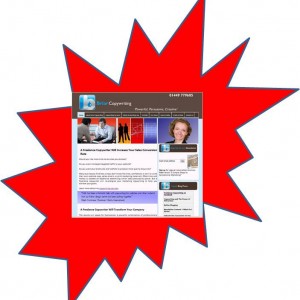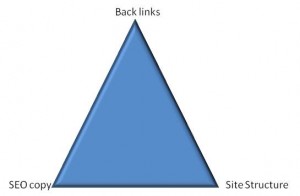Entries Tagged 'freelance copywriter' ↓
July 14th, 2010 — blogging for business, copywriter, freelance copywriter, search engine optimisation
 Every business that uses the internet wants to get found. That’s pretty obvious, right? But how to you go about getting found?
Every business that uses the internet wants to get found. That’s pretty obvious, right? But how to you go about getting found?
Search engine optimisation is obviously a big part of this, which is a subject I’ve talked about a lot on this blog. One aspect of that is building back links.
What’s a back link?
If you want people to find your website, you need lots of arrows pointing to it – these ‘arrows’ are back links. Take, for example, the paragraph above. As you can see there’s a link – search engine optimisation – that is an internal link as it points you to a previous blog post. However if I were to write about a freelance copywriter who would be able to boost your businesses visibility and sales by producing eye-catching sales writing that inspires customers to buy, that is a back link because it’s pointing to an external website.
How do you get back links?
Encouraging people to link to your website takes work. Generating high quality content is the key. If you are providing great information regularly, people will want to link to you. Creating hints and tips in your chosen field will also help elevate you to expert status, and with that comes more links. But there are ways you can also generate links yourself.
Blogging and article marketing are two very effective ways of building back links, especially the most sought after type – the keyword hypertext link. I showed you an example of that earlier by linking the words ‘freelance copywriter’. This just happens to be one of my key phrases. These are the most valuable links as they relate to your chosen keywords. You can generate a lot of links by submitting your website to directories, however they tend to just link by website name (e.g. Briar Copywriting) rather than by your keywords.
Going back to article marketing for a moment, when you post an article and insert a keyword hypertext link into your text, you are effectively funneling a bit of link juice to your website. That might sound a bit strange, but this is how it works. If you use an article site with a high Google Page Rank (e.g. ezinearticles) and they allow you to add hypertext keyword links which are follow links (as opposed to the no follow link), a little bit of page rank is also passed along the link. Therefore the more links like that, the higher your chances of increasing your own website’s page rank.
Another way of generating back links is by guest blogging and using social media and social networking sites. These are great because you can add your profile details to widen your ‘internet footprint’ therefore boosting your chances of being found online. Some sites even provide facilities to create your own micro-site which gives you even more exposure. Taking advantage of opportunities likes these and contributing to forums etc., will boost your exposure.
One giant step…
Generating back links is invaluable and you would do well to get into a routine to create blogs and articles that constantly generate links for you. Make sure the content is fantastic and keyword rich to encourage others to link to you.
But don’t forget about the other elements of SEO. Back links should just be one part of your SEO strategy. You must also consider your website’s structure and content.
 All three elements are essential if you want your website to be found online. But you must remember that SEO is an ongoing process. You have to constantly review your keywords, constantly tweak and update your content to get the optimium amount of traffic and conversions and you must continually build back links.
All three elements are essential if you want your website to be found online. But you must remember that SEO is an ongoing process. You have to constantly review your keywords, constantly tweak and update your content to get the optimium amount of traffic and conversions and you must continually build back links.
Your competitors will be doing all of this, so if you stop you’ll gradually become invisible to online customers.
July 12th, 2010 — copywriter, freelance copywriter, keywords, search engine optimisation
 When people think about search engine optimisation, they immediately start thinking about keywords and search engine rankings. There’s nothing wrong with that, but if you spend every waking hour worrying about that, you might be missing something more concerning; something that could be happening right now.
When people think about search engine optimisation, they immediately start thinking about keywords and search engine rankings. There’s nothing wrong with that, but if you spend every waking hour worrying about that, you might be missing something more concerning; something that could be happening right now.
Every website owner should use Google Analytics. This small powerhouse of stats and graphs will show you how your website is performing. Information such as which keywords bring you the most traffic, sources of your traffic, which pages get the most hits and the geographical spread of your visitors is all at your finger tips. But one of the key stats that will show how effective your website is, is the bounce rate.
What is bounce rate?
The bounce rate is a figure that shows the percentage of visitors to your website that leave within the first 10 seconds. And that’s not good. If visitors are leaving that soon it shows that they haven’t found what they were looking for. A site with a low bounce rate (say below 30%) will be a website that is converting its visitors into customers. A site with a bounce rate of 50% and higher is one that isn’t converting – it’s failing.
If your rate is 50% and above, its time to take a look at your SEO.
Factors affecting bounce rate
Traffic to your website comes from a number of different sources:
- organic search results
- backlinks from referal sites
- repeat visitors
- social bookmarking traffic
- PPC traffic
The source with the lowest bounce rate should be your PPC traffic – if you use pay per click. If the highest rate comes from your organic traffic this would suggest that you have a mismatch with your keywords.
As a freelance copywriter it won’t come as any surprise that that is one of my keywords. So if people Google freelance copywriter they’ll find me. But what if I’d targeted something like marketing agency and they were looking for a company to deal with all their design and branding needs? When they land on my home page they’d find great information about my freelance copywriting services but no mention of design or branding. The result would be that they would click away from my site which would lead to a high bounce rate.

Therefore it is essential you ensure your keyword selection truly reflects what you do. Shed loads of traffic is useless without conversions.
But it might not be just down to your keywords. Here are other factors that may be causing people to click away from you site:
- too much advertising – this could be making your site look messy with too many messages
- videos and music – especially if they are on auto play as soon as your website is opened. The can be really annoying
- navigation choices – too many and your visitors will get confused, too few and they won’t know where to go next
- slow loading speed – peopel don’t like hanging around waiting for websites to load
- excessive corporate speak and jargon in your copy will be a huge turn off
- bad design – if you site looks unattractive it won’t encourage people to stay
So, if you are experiencing high bounce rates take a look at your site and compare it with the list above. Take another look at your keywords – are they really reflecting what your site is about?
If you can bring down your bounce rate you’ll boost your conversations.
July 9th, 2010 — blogging, blogging for business, copywriter, freelance copywriter

As a freelance copywriter, I have been blogging for several years now, so what I do has become second nature. But many of you are probably coming to blogging without any experience and find the whole concept daunting. To me, it is a simple and effective method you can use to promote your business, elevate yourself to expert status within your field and get the word out about what you do.
Last week I had lunch with one of my clients who was quizzing me about various aspects of social media marketing, including blogging. As I enthusiastically launched into a speech outlining all the major benefits that blogging brings, I could see he was drowning in information overload. So I thought the easiest way to explain how to blog effectively was to blog about it.
How to be an effective blogger
The key to blogging is to do it regularly. It’s like all social media, the more you do it, the more exposure you’ll get and the more you’ll get out of it. The optimium blogging frequency will differ depending on who you talk to. Some blog daily, some even multiple times per day. But to be successful, you have to find a frequency that works for you.
Personally, I post blogs three times a week (twice a week on my other blog). This fits in with the time I have available and provides regular content for my readers. Whatever you decide, stick to it. As you gather regular readers they will grow to expect your next ‘installment’ so don’t disappoint them.
To help me stay on course, I tend to blog ahead and schedule the posts. Therefore if I have a ‘quiet’ day I can write several posts, upload them and schedule them for publication – this can save a lot of time.
As you read this, the number of times you blog probably isn’t at the forefront of your mind right now. You’re probably thinking how on earth can you constantly generate new ideas? Well, we’ll look at that next.
Ideas factory
Coming up with new material can seem daunting when you’re first starting out. So here are some tips to make sure those ideas keep flowing:
- keep a pad on your desk so when an idea comes to you, you can jot it down
- read other industry blogs and magazines to generate ideas
- comment on current affairs especially if you can tie them into your industry
- invite your readers to comment – you may get some spin off ideas from these
- write ‘how to articles’ and ‘top tips’ relating to what you do
Before you know it, you’ll have a stack of articles ready to go.
What’s your purpose?
As you are writing, make sure you know why you are writing. Every post must be created with a purpose. You may be looking to promote something through your writing, perhaps you want to start a discussion, you might be after more business or perhaps you want to attract links.
Whatever it is, keep this in the forefront of your mind as you write.
Every post is valuable so make sure you make it work for you.
Giving something back
Don’t forget, if you want people to take time out of their busy day to read your posts, you have to give them something in return.
The information has to be of value to them. Plus, try to remain on topic. What do I mean? Well, this blog is all about copywriting tips, marketing tips, how to use social media marketing and copywriting SEO related issues. So when a post is published you, my readers, know roughly what genre it will be about. If you bombard your readers with random posts they probably won’t come back for more.
Make your blog an encyclopedia for your area of expertise.
Write simply and with love
The layout of your blog post is very important. It has to be attractive and not too heavy.
Begin with a catchy heading. It should be interesting enough to draw in your reader so arouse their curiosity. To help your SEO, get your keyword in there – so if you are writing about copywriting, try and get that into the heading if you can.
Next comes an image. You may not see that as important, but a good image will draw readers in. Use something playful, something that will pique their curiosity.
Then comes the hard part – writing an interesting and entertaining post. Make sure the body of your post is packed with useful information. You know the audience you are targeting and therefore you’ll know what they are looking for – so give to them in spades. Break up the copy with sub headings to make it easier to read. And finally don’t let it go out with a fizzle; invite comments or add in a call to action (depending on what the aim of your post is).
So that’s how I go about blogging. What do you do? Do you have any other ideas to help out the new bloggers on the block?
July 7th, 2010 — copywriter, freelance copywriter, SEO copywriter
 Even though the World Cup seems to have taken over life as we know it, I’m sure the fact that Wimbeldon is happening hasn’t past you by. And how could it after that epic of tennis matches between Mahut and Isner. Those incredible guys played for a mind blowing 11 hours and 5 minutes in total with Isner eventually winning 6-4 3-6 6-7 7-6 70-68! Imagine that – being on court and not being able to break your opponents serve. Hour after hour you serve and return to the best of your ability and yet still nothing. The number of games played grows to an astronomical number – the sheer will power these guys must have had is astounding.
Even though the World Cup seems to have taken over life as we know it, I’m sure the fact that Wimbeldon is happening hasn’t past you by. And how could it after that epic of tennis matches between Mahut and Isner. Those incredible guys played for a mind blowing 11 hours and 5 minutes in total with Isner eventually winning 6-4 3-6 6-7 7-6 70-68! Imagine that – being on court and not being able to break your opponents serve. Hour after hour you serve and return to the best of your ability and yet still nothing. The number of games played grows to an astronomical number – the sheer will power these guys must have had is astounding.
And by now I guess you’re wondering what on earth a mammoth game of tennis has to do with SEO copywriting. Well, as being as you’re still reading, I’ll tell you. Just like Isner, if you want to win with your SEO strategy you have to be in it for the long haul.
Looking back through this blog you’ll find various posts addressing SEO and yet many people out there still think that once you’ve identified your keywords, got a SEO savvy web designer to build you a stonking site and got the best SEO Copywriter out there to create powerful, meaningful, interesting and relevant copy, you’ll hit the front page of Google just like that.
Oh if only it were that easy.
There is a simple equation that will show you what it takes to succceed with your website’s SEO:
SEO friendly website + great SEO copy + back links + determination = great rankings
If you want to achieve great organic rankings you must:
- do great keyword research
- get a professional to write your copy for you
- constantly build back links to your website (via blogs,articles etc.)
- review your analytics regularly to see your site’s performance
- regularly review your keywords
Basically it is an ongoing process that never stops – that might seem like a lot of work, but when you consider how much money you’ll save it won’t seem so bad. Great search engine results will reduce the need for other paid advertising. So what would you rather do? Spend a bit of time getting clients for nothing, or spend a shed load of cash on ineffective advertising?
The decision is yours. But I know which I would prefer.
July 2nd, 2010 — copywriter, freelance copywriter, social media, social media marketing

Many companies are now beginning to find their feet with social media. They’re getting their heads around tweeting, Facebook. Google Wave and all the other weird and wonderful platforms out there. They are discovering which social media platform to use, they just don’t know how.
But for many, finding customers is still a big issue. Until they can qualify their time spent tweeting etc., with an increase in business they remain sceptical about its uses in the business world.
The key thing to remember is that just because you are using social media doesn’t mean customers will come flooding to your door. It doesn’t work like that. As a business you have to follow customers across the social web.
I came across a blog post the other day that will help you achieve this. Convince and Convert’s “4 Detective tricks to find your customer in social media” will help you understand how to use social media as part of your business.
Sally Ormond – freelance copywriter
 Every business that uses the internet wants to get found. That’s pretty obvious, right? But how to you go about getting found?
Every business that uses the internet wants to get found. That’s pretty obvious, right? But how to you go about getting found? All three elements are essential if you want your website to be found online. But you must remember that SEO is an ongoing process. You have to constantly review your keywords, constantly tweak and update your content to get the optimium amount of traffic and conversions and you must continually build back links.
All three elements are essential if you want your website to be found online. But you must remember that SEO is an ongoing process. You have to constantly review your keywords, constantly tweak and update your content to get the optimium amount of traffic and conversions and you must continually build back links. When people think about
When people think about 

 Even though the World Cup seems to have taken over life as we know it, I’m sure the fact that Wimbeldon is happening hasn’t past you by. And how could it after that epic of tennis matches between Mahut and Isner. Those incredible guys played for a mind blowing 11 hours and 5 minutes in total with Isner eventually winning 6-4 3-6 6-7 7-6 70-68! Imagine that – being on court and not being able to break your opponents serve. Hour after hour you serve and return to the best of your ability and yet still nothing. The number of games played grows to an astronomical number – the sheer will power these guys must have had is astounding.
Even though the World Cup seems to have taken over life as we know it, I’m sure the fact that Wimbeldon is happening hasn’t past you by. And how could it after that epic of tennis matches between Mahut and Isner. Those incredible guys played for a mind blowing 11 hours and 5 minutes in total with Isner eventually winning 6-4 3-6 6-7 7-6 70-68! Imagine that – being on court and not being able to break your opponents serve. Hour after hour you serve and return to the best of your ability and yet still nothing. The number of games played grows to an astronomical number – the sheer will power these guys must have had is astounding.





